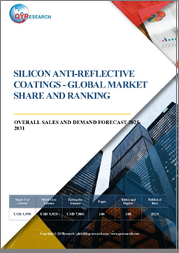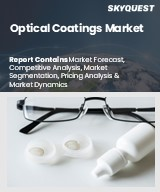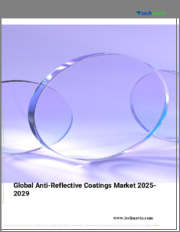
|
시장보고서
상품코드
1702069
반사 방지 코팅 시장 보고서 : 기술, 층 유형, 용도, 지역별(2025-2033년)Anti-reflective Coatings Market Report by Technology, Layer Type, Application, and Region 2025-2033 |
||||||
반사 방지 코팅 세계 시장 규모는 2024년에 53억 달러에 달했습니다. 향후 IMARC Group은 2033년까지 시장 규모가 85억 달러에 달하고, 2025-2033년 5.14%의 연평균 성장률(CAGR)을 보일 것으로 전망하고 있습니다. 이 시장은 주로 안경, 전자제품, 태양에너지 등 주요 분야 수요 증가에 의해 주도되고 있습니다. 또한, 디스플레이의 선명도와 에너지 효율을 향상시키는 용도으로 인해 시장이 계속 확대되고 있으며, 아시아태평양은 탄력적인 기술과 제조 부문으로 인해 시장을 주도하고 있습니다.
반사 방지 코팅은 광학 표면으로부터의 반사를 최소화하도록 배합된 광학 코팅을 말합니다. 자외선, 가시광선, 근적외선의 투과와 반사를 제어하는 것 외에도 유전체 코팅은 온도와 습도 조절에도 기여합니다. 이러한 코팅의 결과로 시야의 선명도가 향상되고 블루라이트와 자외선의 투과를 방지할 수 있습니다. 렌즈나 거울과 같은 광학 표면에 적용하면 반사율을 제어하여 반사를 줄이고 전송을 증가시켜 처리량을 향상시킵니다. 또한 망원경이나 태양전지판과 같은 복잡한 영상 시스템의 가시성과 대비를 향상시킵니다. 반사 방지 소재로 코팅된 안경은 긁힘, 먼지, 물에 강하고 선명한 시야를 제공합니다. 그 결과, 이러한 소재는 반도체, 자동차, 건축, 전자기기, 태양광 발전, 항공우주 산업 등에 널리 적용되고 있습니다.
반사 방지 코팅 시장 동향 :
렌즈 및 안경 제조에서 반사 방지 코팅에 대한 수요가 증가하면서 시장을 주도하고 있습니다. 이와 더불어, 건설 산업에서 고투과율 반사 방지 유리의 채택이 증가하면서 시장에 활력을 불어넣고 있습니다. 또한, 스마트폰, TV, 노트북, 노트북 및 기타 전자기기의 화면 보호 요소로 제품이 빠르게 활용되고 있는 것도 시장의 중요한 성장 촉진요인으로 작용하고 있습니다. 또한, 재생 가능 에너지원에 대한 수요 증가로 인한 태양광 패널 설치율 증가는 전 세계적으로 제품 수요를 증가시키고 있습니다. 또한, 발유, 셀프 클리닝, 나노 스케일 산화물 코팅의 등장과 같은 끊임없는 제품 혁신이 시장을 주도하고 있습니다. 기타 시장 개척 요인으로는 시력 장애 증가, 급속한 도시화 및 산업화, 광범위한 조사 개발 활동 등을 들 수 있습니다.
본 보고서에서 다룬 주요 질문
- 2024년 세계 반사 방지 코팅 시장 규모는?
- 2025-2033년 세계 반사 방지 코팅 시장의 예상 성장률은?
- 세계 반사 방지 코팅 시장을 이끄는 주요 요인은?
- 코로나19가 세계 반사 방지 코팅 시장에 미치는 영향은?
- 세계 반사 방지 코팅 시장의 기술별 시장 현황은?
- 세계 반사 방지 코팅 시장의 레이어 유형별 시장 분석은?
- 세계 반사 방지 코팅 시장의 용도별 시장 현황은?
- 세계 반사 방지 코팅 시장의 주요 지역은?
- 세계 반사 방지 코팅 시장의 주요 기업은?
목차
제1장 서문
제2장 조사 범위와 조사 방법
- 조사 목적
- 이해관계자
- 데이터 소스
- 1차 정보
- 2차 정보
- 시장 추정
- 보텀업 접근
- 톱다운 접근
- 조사 방법
제3장 주요 요약
제4장 서론
- 개요
- 주요 업계 동향
제5장 세계의 반사 방지 코팅 시장
- 시장 개요
- 시장 실적
- COVID-19의 영향
- 시장 예측
제6장 시장 분석 : 기술별
- 진공 증착
- 전자빔 증착
- 스퍼터링
- 기타
제7장 시장 분석 : 레이어 유형별
- Single Layered
- Multi Layered
제8장 시장 분석 : 용도별
- 안경류
- 일렉트로닉스
- 태양전지판
- 자동차
- 기타
제9장 시장 분석 : 지역별
- 북미
- 미국
- 캐나다
- 아시아태평양
- 중국
- 일본
- 인도
- 한국
- 호주
- 인도네시아
- 기타
- 유럽
- 독일
- 프랑스
- 영국
- 이탈리아
- 스페인
- 러시아
- 기타
- 라틴아메리카
- 브라질
- 멕시코
- 기타
- 중동 및 아프리카
- 시장 내역 : 국가별
제10장 SWOT 분석
- 개요
- 강점
- 약점
- 기회
- 위협
제11장 밸류체인 분석
제12장 Porter의 Five Forces 분석
- 개요
- 바이어의 교섭력
- 공급 기업의 교섭력
- 경쟁 정도
- 신규 진출업체의 위협
- 대체품의 위협
제13장 가격 분석
제14장 경쟁 구도
- 시장 구조
- 주요 기업
- 주요 기업 개요
- AGC Inc.
- Carl Zeiss AG
- DuPont de Nemours Inc.
- Essilor International(EssilorLuxottica SA)
- Evaporated Coatings Inc.
- Honeywell International Inc.
- HOYA Corporation
- iCoat Company LLC
- Koninklijke DSM N.V.
- Quantum Coating Inc.
- Spectrum Direct Limited
- Torr Scientific Ltd.
The global anti-reflective coatings market size reached USD 5.3 Billion in 2024. Looking forward, IMARC Group expects the market to reach USD 8.5 Billion by 2033, exhibiting a growth rate (CAGR) of 5.14% during 2025-2033. The market is primarily driven by heightening demand in key sectors like eyewear, electronics, and solar energy. Moreover, with applications improving display clarity and energy efficiency, the market continues to expand, with Asia Pacific dominating the market due to its resilient technology and manufacturing segments.
Anti-reflective coatings refer to the optical coatings that are formulated to minimize reflections from an optical surface. Along with controlling transmission and reflection of ultraviolet, visible, and near-infrared radiations, these dielectric coatings also contribute to the controlling of temperature and humidity. As a result of these coatings, vision clarity is improved and blue light and ultraviolet ray penetration is prevented. When applied to lenses, mirrors, or other optical surfaces, they reduce reflection, increase transmission, and enhance the throughput by controlling the reflexive index. Additionally, they improve visibility and contrast for complex imaging systems, such as telescopes and solar panels. Eyewear coated with anti-reflective materials provides a crisp view while being resistant to scratching, dust, and water. As a result, these materials find widespread applications in the semiconductor, automotive, construction, electronics, solar power, and aerospace industries.
Anti-reflective Coatings Market Trends:
The market is majorly driven by the escalating demand for anti-reflective coatings for manufacturing lenses and glasses. In addition to this, the rising adoption of high transmitting anti-reflective glasses in the construction industry is providing an impetus to the market. Also, the rapid product utilization as a protective element on the screens of smartphones, televisions, laptops, and other electronic gadgets is a significant growth-inducing factor for the market. Moreover, the growing rates of solar panel installations due to increasing demand for renewable sources of energy are augmenting the product demand on the global level. The market is further driven by continual product innovations, such as the advent of oil repellant, self-cleaning and nano scale oxide coatings. Some of the other factors contributing to the market growth include the growing prevalence of vision impairment, rapid urbanization and industrialization, and extensive research and development (R&D) activities.
Key Market Segmentation:
Breakup by Technology:
- Vacuum Deposition
- Electronic Beam Evaporation
- Sputtering
- Others
Breakup by Layer Type:
- Single Layered
- Multi Layered
Breakup by Application:
- Eyewear
- Electronics
- Solar Panels
- Automobile
- Others
Breakup by Region:
- North America
- United States
- Canada
- Asia-Pacific
- China
- Japan
- India
- South Korea
- Australia
- Indonesia
- Others
- Europe
- Germany
- France
- United Kingdom
- Italy
- Spain
- Russia
- Others
- Latin America
- Brazil
- Mexico
- Others
- Middle East and Africa
Competitive Landscape:
The competitive landscape of the industry has also been examined along with the profiles of the key players being AGC Inc., Carl Zeiss AG, DuPont de Nemours Inc., Essilor International (EssilorLuxottica SA), Evaporated Coatings Inc., Honeywell International Inc., HOYA Corporation, iCoat Company LLC, Koninklijke DSM N.V., Quantum Coating Inc., Spectrum Direct Limited and Torr Scientific Ltd.
Key Questions Answered in This Report
- 1.What was the size of the global anti-reflective coatings market in 2024?
- 2.What is the expected growth rate of the global anti-reflective coatings market during 2025-2033?
- 3.What are the key factors driving the global anti-reflective coatings market?
- 4.What has been the impact of COVID-19 on the global anti-reflective coatings market?
- 5.What is the breakup of the global anti-reflective coatings market based on the technology?
- 6.What is the breakup of the global anti-reflective coatings market based on the layer type?
- 7.What is the breakup of the global anti-reflective coatings market based on application?
- 8.What are the key regions in the global anti-reflective coatings market?
- 9.Who are the key players/companies in the global anti-reflective coatings market?
Table of Contents
1 Preface
2 Scope and Methodology
- 2.1 Objectives of the Study
- 2.2 Stakeholders
- 2.3 Data Sources
- 2.3.1 Primary Sources
- 2.3.2 Secondary Sources
- 2.4 Market Estimation
- 2.4.1 Bottom-Up Approach
- 2.4.2 Top-Down Approach
- 2.5 Forecasting Methodology
3 Executive Summary
4 Introduction
- 4.1 Overview
- 4.2 Key Industry Trends
5 Global Anti-reflective Coatings Market
- 5.1 Market Overview
- 5.2 Market Performance
- 5.3 Impact of COVID-19
- 5.4 Market Forecast
6 Market Breakup by Technology
- 6.1 Vacuum Deposition
- 6.1.1 Market Trends
- 6.1.2 Market Forecast
- 6.2 Electronic Beam Evaporation
- 6.2.1 Market Trends
- 6.2.2 Market Forecast
- 6.3 Sputtering
- 6.3.1 Market Trends
- 6.3.2 Market Forecast
- 6.4 Others
- 6.4.1 Market Trends
- 6.4.2 Market Forecast
7 Market Breakup by Layer Type
- 7.1 Single Layered
- 7.1.1 Market Trends
- 7.1.2 Market Forecast
- 7.2 Multi Layered
- 7.2.1 Market Trends
- 7.2.2 Market Forecast
8 Market Breakup by Application
- 8.1 Eyewear
- 8.1.1 Market Trends
- 8.1.2 Market Forecast
- 8.2 Electronics
- 8.2.1 Market Trends
- 8.2.2 Market Forecast
- 8.3 Solar Panels
- 8.3.1 Market Trends
- 8.3.2 Market Forecast
- 8.4 Automobile
- 8.4.1 Market Trends
- 8.4.2 Market Forecast
- 8.5 Others
- 8.5.1 Market Trends
- 8.5.2 Market Forecast
9 Market Breakup by Region
- 9.1 North America
- 9.1.1 United States
- 9.1.1.1 Market Trends
- 9.1.1.2 Market Forecast
- 9.1.2 Canada
- 9.1.2.1 Market Trends
- 9.1.2.2 Market Forecast
- 9.1.1 United States
- 9.2 Asia-Pacific
- 9.2.1 China
- 9.2.1.1 Market Trends
- 9.2.1.2 Market Forecast
- 9.2.2 Japan
- 9.2.2.1 Market Trends
- 9.2.2.2 Market Forecast
- 9.2.3 India
- 9.2.3.1 Market Trends
- 9.2.3.2 Market Forecast
- 9.2.4 South Korea
- 9.2.4.1 Market Trends
- 9.2.4.2 Market Forecast
- 9.2.5 Australia
- 9.2.5.1 Market Trends
- 9.2.5.2 Market Forecast
- 9.2.6 Indonesia
- 9.2.6.1 Market Trends
- 9.2.6.2 Market Forecast
- 9.2.7 Others
- 9.2.7.1 Market Trends
- 9.2.7.2 Market Forecast
- 9.2.1 China
- 9.3 Europe
- 9.3.1 Germany
- 9.3.1.1 Market Trends
- 9.3.1.2 Market Forecast
- 9.3.2 France
- 9.3.2.1 Market Trends
- 9.3.2.2 Market Forecast
- 9.3.3 United Kingdom
- 9.3.3.1 Market Trends
- 9.3.3.2 Market Forecast
- 9.3.4 Italy
- 9.3.4.1 Market Trends
- 9.3.4.2 Market Forecast
- 9.3.5 Spain
- 9.3.5.1 Market Trends
- 9.3.5.2 Market Forecast
- 9.3.6 Russia
- 9.3.6.1 Market Trends
- 9.3.6.2 Market Forecast
- 9.3.7 Others
- 9.3.7.1 Market Trends
- 9.3.7.2 Market Forecast
- 9.3.1 Germany
- 9.4 Latin America
- 9.4.1 Brazil
- 9.4.1.1 Market Trends
- 9.4.1.2 Market Forecast
- 9.4.2 Mexico
- 9.4.2.1 Market Trends
- 9.4.2.2 Market Forecast
- 9.4.3 Others
- 9.4.3.1 Market Trends
- 9.4.3.2 Market Forecast
- 9.4.1 Brazil
- 9.5 Middle East and Africa
- 9.5.1 Market Trends
- 9.5.2 Market Breakup by Country
- 9.5.3 Market Forecast
10 SWOT Analysis
- 10.1 Overview
- 10.2 Strengths
- 10.3 Weaknesses
- 10.4 Opportunities
- 10.5 Threats
11 Value Chain Analysis
12 Porters Five Forces Analysis
- 12.1 Overview
- 12.2 Bargaining Power of Buyers
- 12.3 Bargaining Power of Suppliers
- 12.4 Degree of Competition
- 12.5 Threat of New Entrants
- 12.6 Threat of Substitutes
13 Price Analysis
14 Competitive Landscape
- 14.1 Market Structure
- 14.2 Key Players
- 14.3 Profiles of Key Players
- 14.3.1 AGC Inc.
- 14.3.1.1 Company Overview
- 14.3.1.2 Product Portfolio
- 14.3.1.3 Financials
- 14.3.1.4 SWOT Analysis
- 14.3.2 Carl Zeiss AG
- 14.3.2.1 Company Overview
- 14.3.2.2 Product Portfolio
- 14.3.2.3 SWOT Analysis
- 14.3.3 DuPont de Nemours Inc.
- 14.3.3.1 Company Overview
- 14.3.3.2 Product Portfolio
- 14.3.3.3 Financials
- 14.3.3.4 SWOT Analysis
- 14.3.4 Essilor International (EssilorLuxottica SA)
- 14.3.4.1 Company Overview
- 14.3.4.2 Product Portfolio
- 14.3.5 Evaporated Coatings Inc.
- 14.3.5.1 Company Overview
- 14.3.5.2 Product Portfolio
- 14.3.6 Honeywell International Inc.
- 14.3.6.1 Company Overview
- 14.3.6.2 Product Portfolio
- 14.3.6.3 Financials
- 14.3.6.4 SWOT Analysis
- 14.3.7 HOYA Corporation
- 14.3.7.1 Company Overview
- 14.3.7.2 Product Portfolio
- 14.3.7.3 Financials
- 14.3.7.4 SWOT Analysis
- 14.3.8 iCoat Company LLC
- 14.3.8.1 Company Overview
- 14.3.8.2 Product Portfolio
- 14.3.9 Koninklijke DSM N.V.
- 14.3.9.1 Company Overview
- 14.3.9.2 Product Portfolio
- 14.3.9.3 Financials
- 14.3.9.4 SWOT Analysis
- 14.3.10 Quantum Coating Inc.
- 14.3.10.1 Company Overview
- 14.3.10.2 Product Portfolio
- 14.3.11 Spectrum Direct Limited
- 14.3.11.1 Company Overview
- 14.3.11.2 Product Portfolio
- 14.3.12 Torr Scientific Ltd.
- 14.3.12.1 Company Overview
- 14.3.12.2 Product Portfolio
- 14.3.1 AGC Inc.



















